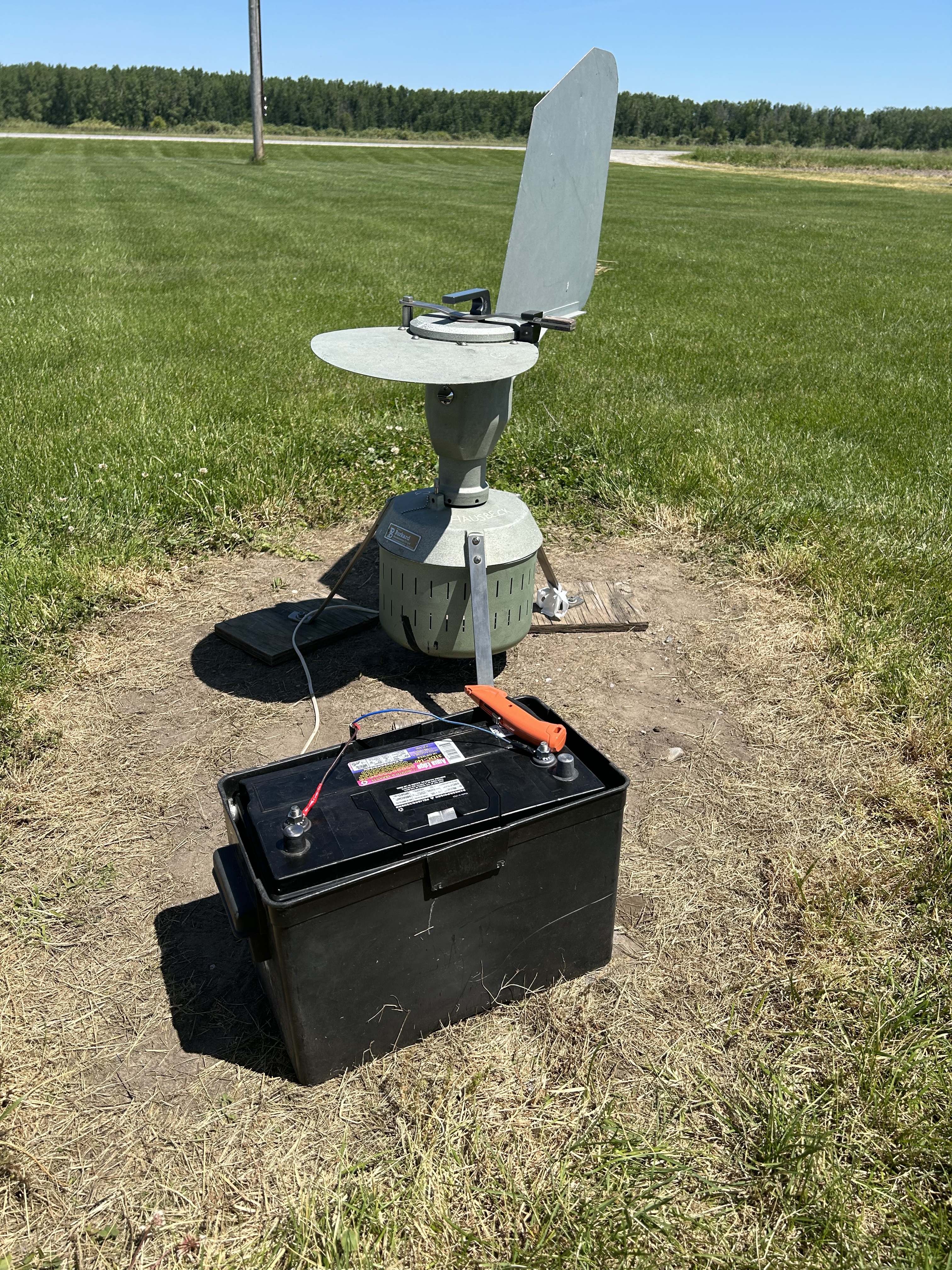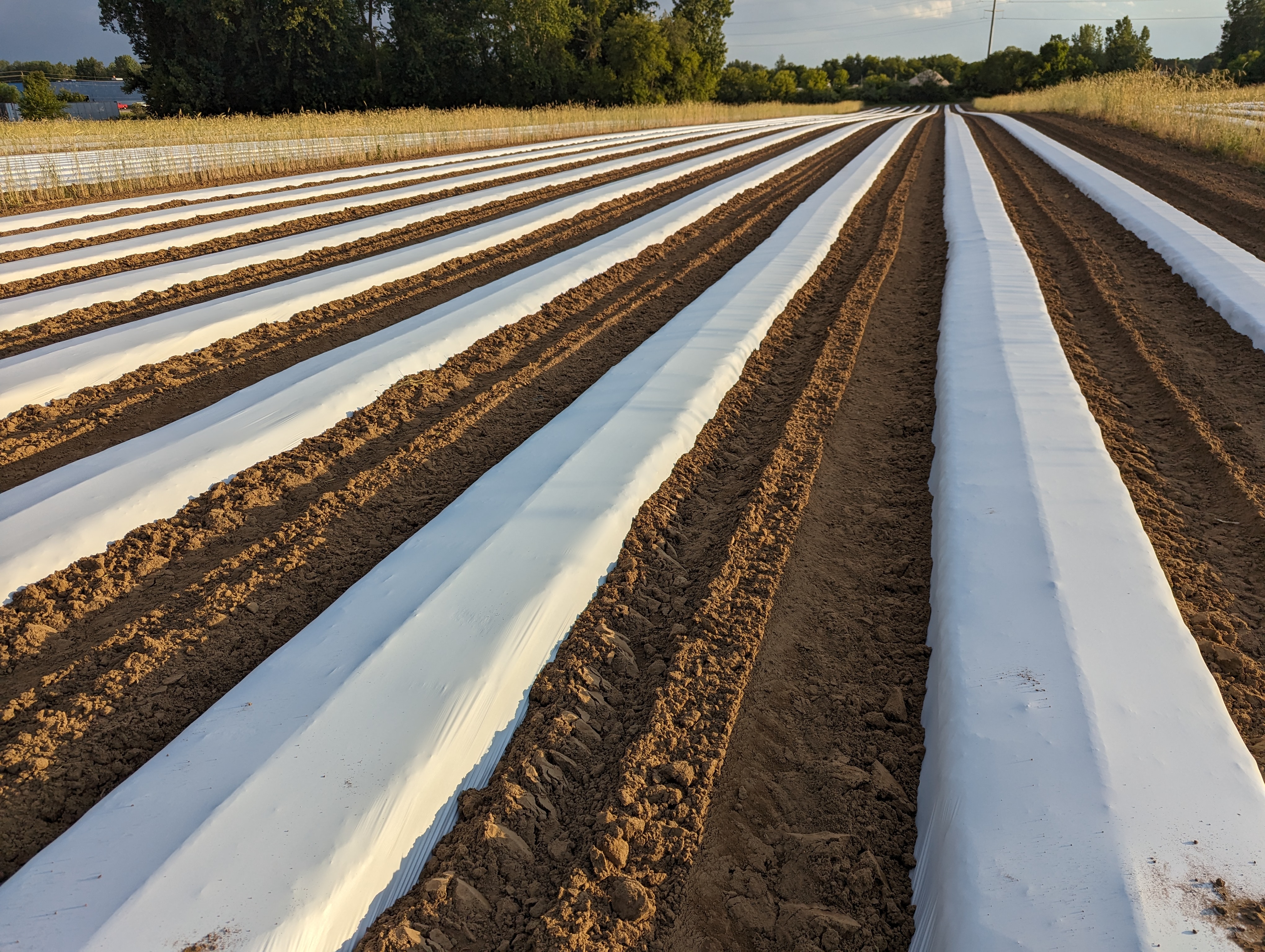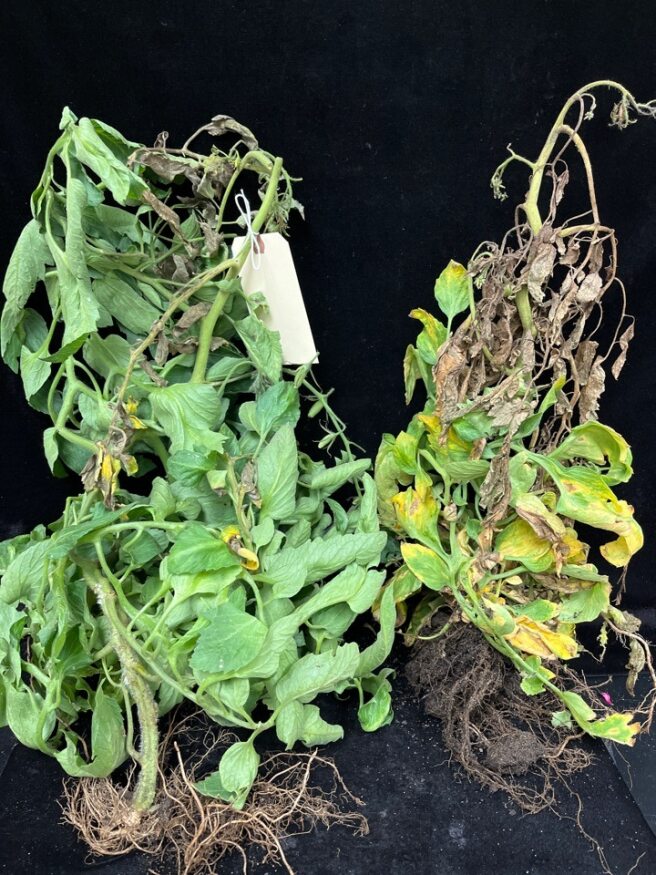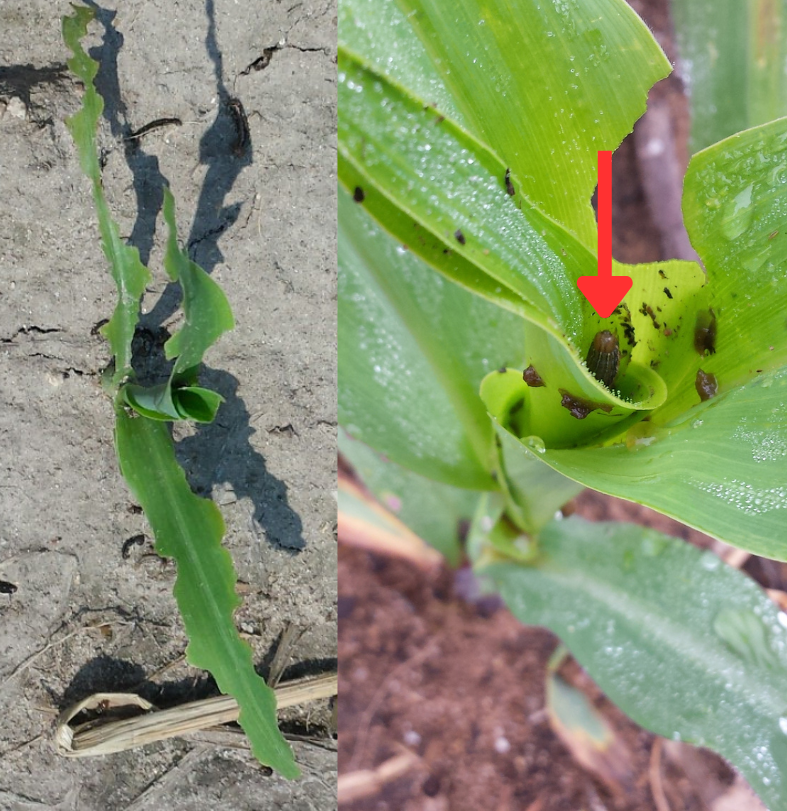Michigan vegetable crop report – June 12, 2024
Vegetable crops and pests are progressing.

Weather
Mean temperatures for the past week were close to normal with variable precipitation. Degree-day totals are several calendar days to a week ahead of normal. Soil moisture varies from above normal in upper northwest Michigan to drier than normal in the south. Soil moisture has decreased from a few weeks back, which is normal for this time of year.
This week’s forecast features:
- Scattered showers and thunderstorms possible to the north Wednesday (June 12) during the day. Variably cloudy and warmer to the east and south. Scattered showers and thunderstorms possible overnight Wednesday and Thursday, especially to the north. Some strong storms possible northwest Wednesday evening and to the south Thursday evening. Fair, dry and slightly cooler Friday and most of Saturday. Variably cloudy, much warmer and more humid with scattered showers and thunderstorms possible on a daily basis Sunday though early next week.
- High temperatures in the 80s Wednesday and Thursday falling back to the 70s to low 80s Friday and Saturday then warming again to the 80s and 90s Sunday through early next week. Low temperatures falling from the 60s Thursday morning to the upper 40s to mid-50s Saturday, then warming to the 60s again by early next week.
- Above normal daily PET rates expected this week (daily values from 0.17 – 0.25 inches).
- Medium range outlooks generally call for warmer than normal temperatures and near to above normal precipitation totals.
Produce Food Safety On-Farm Readiness Reviews
On May 2, the U.S. Food and Drug Administration (FDA) released their final revisions to the Food Safety Modernization Act Produce Safety Rule Pre-Harvest Agricultural Water Rule. If you are a grower in Michigan, this is a great time to schedule an On-Farm Readiness Review (OFRR). Not only can our team help you assess your on-farm produce safety risks, we can help you assess your water system in light of the updated water rule. If you have already had an OFRR on your farm, no problem, we are happy to come back out to help you assess your water system based on the new parts of the water rule.
An On-Farm Readiness Review (OFRR) is an opportunity for a grower to walk around their farm with their local conservation district produce safety technician and a produce safety specialist from Michigan State University Extension. These 2-hour educational visits take place during the harvest season and are meant to be casual and low stress. Everything discussed during an OFRR is confidential and focused on ways a grower can reduce their own risks in relation to produce safety. There is no pressure to take our advice either, we are just here to support you in your produce safety efforts!
Crop updates
Asparagus
The end of harvest is the second and final time for weed control during the asparagus season, and is a good time to chip away at perennial weeds. For tall perennials (milkweed, Canada thistle) one option is to “strip” the field clean (picking all the asparagus that’s up) while leaving plenty of leaf surface area to take in systemic herbicides. For short stature ones, like field bindweed, mowing should leave enough leaf surface to make this step unnecessary.
What systemic herbicides are out there? Roundup (glyphosate) is a main tool for control of perennials including milkweed and quackgrass. Experience has shown that including an acidifier is important for maximizing control. The other tools include auxin inhibiting herbicides with various levels of crop safety and weed specificity. Clopyralid (in Spur) is our best tool for Canada thistle, but at times can cause injury as fern develops. Quinclorac (in Quinstar 4L) is a good tool for field bindweed and also has thistle activity. 2,4-D is commonly included in postharvest sprays and can help broaden the spectrum of the burndown component of the cocktail. Dicamba is another auxin inhibiting herbicide but can cause injury as fern develops.
Speaking of burndowns, drift can also be a concern when fields get shutdown at different times. Here are a few tips from a presentation Jason Deveau of the Ontario Ministry of Agriculture, Food and Rural Affairs (OMAFRA) gave a number of years ago:
- Keep booms low and go slow.
- Use the coarsest nozzle possible given the product you need to apply.
- A little bit of wind is good: Inversions tend to form after sunset and dissipate after sunrise once a light breeze picks up.
Note there are two kinds of drift: particle drift and vapor drift. Particle drift is when droplets are carried away by the wind; it’s what we are most used to and occurs over feet. It creates patterns that make sense: injury on the side of the field downwind from the application site. Cooler and/or windy conditions favor particle drift (slow drying times and/or wind to pick up the product). Vapor drift happens when volatile herbicides are picked up and can happen over miles. Hot conditions that evaporate the water in the droplet favor this type of drift. 2,4-D and dicamba are herbicides that can volatilize. There is a formulation of 2,4-D called Embed Extra that may help to some degree, and using a bit more water volume and coarse droplets can also help.
Pigweed is a most troublesome annual weed in asparagus and can form a dense canopy by the end of harvest. Some farms have experimented with burning it down before applying preemergence herbicides. The idea is to remove the pigweed canopy so pre herbicides can reach the soil surface. No research data to support this practice! Just growers experimenting to deal with a persistent problem.
Brassicas and greens
Transplanting of cabbage, broccoli, cauliflower, brussel sprouts and other brassicas continues. Direct-seeded brassica greens are being harvested. Early planted radishes, kale, collards and mustard greens are being harvested. Scouts in southest Michigan are trapping diamondback moth and cabbage looper. Caterpillar feeding and swede midge feeding damage is being observed. Imported cabbage worm adults (cabbage white butterflies) are flying.
Carrots and celery
Aster leafhopper infectivity was still high in a sample from Oceana County carrots this week. Pyrethroids such as Asana can provide effective control. For information on aster leafhopper thresholds and aster yellow infectivity risk, check out this recent article from Zsofia Szendrei and consider signing up for the text alert system. Carrots are several inches tall and the nurse crop has been killed in the earliest plantings. Later fresh-market plantings were still going in last week.
Cucurbits
All types of vine crops are being planted. Field-planted cucumbers and zucchini are close to the first harvest in southwest Michigan, and hoophouse crops are already yielding. Angular leaf spot has been found in at least one farm, which can look like downy mildew. According to Cucurbit Downy Mildew Forecasting, at this point downy mildew has not been found north of North Carolina. However, the Hausbeck lab at Michigan State University has begun deploying its spore traps for monitoring downy mildew as it begins to move closer to us. Both the weekly spore counts and infection reports can be viewed at the Hausbeck Downy Mildew News website.

Fruiting vegetables
Early plantings are being trellised, and more plastic is being laid for later plantings.

Fungicide applications are underway to protect tomatoes from foliar diseases. Many infections that cause damage to leaves can also cause lesions on fruit. While there are a few fungicides approved for organic usage, many are not. A non-chemical approach to disease management relies on cultural practices—sanitation, rotation, using resistant varieties, maintaining airflow around plants and even hot-water treatment for some of the seed-borne pathogens. In high tunnel production where there is often an incentive to grow tomatoes year-after-year, there are additional practices for mitigating soil-borne pathogens that build up in the absence of crop rotation, which include soil steaming or grafting productive varieties to resistant rootstocks.
Be watchful for wilting symptoms on larger plants in hoop houses and in the field. Both Verticillium wilt and bacterial canker cause yellowing, stunting, internal stem discoloration and wilting of infected plants. Disease management strategies differ greatly for these two diseases so accurate diagnosis is important. Note that if you wish to send symptomatic plants to a diagnostic lab it is helpful to send entire plants; the diagnostic process typically uses root, stem and foliage.


Onions
Some onion growers were on their second fungicide application for Stemphylium this week, and others are initiating programs according to crop stage. Remember, it is important to use a highly effective fungicide—Luna Tranquility or Miravis Prime—early in the program (even at the first application). Control is also improved with seven- versus 10-day intervals. Mary Hausbeck recently shared that our abnormally warm overnights are concerning (even though it was recently cool, that has not been the rule!). Read more in the May 29 vegetable report.
Onion thrips control programs are starting. In some parts of the state, the first Movento application was made this week on earlier plantings, while other fields were slated for next week. Zsofia Szendrei is conducting a trial this year to look at insecticides in the slots following Movento, with the goal of identifying effective products that reduce the total number of needed applications. As part of this trial, her lab is counting onion thrips. Szendrei shared that at that location, the thrips threshold for the first application of Movento had not been reached as of last week but may occur with the warm up this week. At another location this week, there were likewise some adults but very few immatures, and the field was below the threshold of 0.6 thrips per leaf. Fields may vary, which is why scouting is important. The coming heat will accelerate population growth.
Some other notes about Movento:
- Make sure to follow the first application with a second seven to 10 days later.
- Apply it before bulbing begins.
- Use a penetrating surfactant.
- Tank mixing with chlorothalonil reduces efficacy.
Cornell University publishes research-based onion thrips guidelines each year. Please check out the week by week, choose your own adventure format.
Peas and beans
Peas are being harvested in southwest and eastern part of Michigan. Early plantings of beans are flowering.
Root crops and potatoes
Radishes and turnips are ready in many areas. Colorado potato beetles can be found in all life stages now. It may be worth a foliar application of insecticide if you did not use an at-plant treatment. For organic growers, the insecticide spinosad can provide control of early life stages of Colorado potato beetle.
Strawberries
Strawberry season is 70-80% done in the eastern part of the state. The strawberry season started two weeks earlier this year due to the warm temperature.
Sweet corn
True armyworm is a spotty pest that may have popped up at some locations over the past week. A key risk factor is the presence of a healthy rye cover crop, either before corn or in the neighborhood. True armyworms are a migratory pest, with momma moths blowing up from the south. They love to lay eggs in grasses where caterpillars hatch and feed. Once the cover crop is terminated, the caterpillars will feed on corn. They hide out during the day in corn whorls but take characteristic leaf chomps out of leaf edges at night. Conventional pyrethroids provide cheap, effective control.

Speaking of worms, it is time to start dusting off traps and bookmarking weblinks that provide pest updates:
- Video tutorial on pheromone trapping for corn earworm
- Corn earworm forecaster
- Purdue University Corn earworm trapping network
- Ohio State University C.O.R.N newsletter (check the “lep monitoring network” weekly update)
- Purdue Pest & Crop Newsletter (helpful for black cutworm and armyworm)
Events
- June 13, 7-8 a.m., Field Crops Virtual Breakfast Series: Irrigation Management
- June 18, 6-8 p.m., Veggie Vibes at SWMREC
- June 19, 9 a.m.-1:30 p.m., Food-Grade Grains Field Day
- June 20, 7-8 a.m., Field Crops Virtual Breakfast Series: Wild Weather for Hay
- June 25, Michigan Wheat Program Summer Field Day
- June 26, Weed Tour Field Day
- June 27, 7-8 a.m., Field Crops Virtual Breakfast Series: Insect Update Beneficials & Corn Borer
- July 11, 7-8 a.m., Field Crops Virtual Breakfast Series: Cercospora for Sugarbeets
- July 16, 6-8 p.m., Veggie Vibes at SWMREC
- July 18, 7-8 a.m., Field Crops Virtual Breakfast Series: White Mold - Tar Spot Spraying – Will it Pay?
- July 25, 7-8 a.m., Field Crops Virtual Breakfast Series: Hot Topics Q&A Session
- Aug. 1, 7-8 a.m., Field Crops Virtual Breakfast Series: Cover Crops After Wheat
- Aug. 2, 10 a.m.-2 p.m., Organic Inspection Field Day at The North Farm
- Aug. 8, 7-8 a.m., Field Crops Virtual Breakfast Series: MSU Diagnostic Lab Topics
- Aug. 8, Potato Field Day at the Montcalm Research Center, Lakeview, MI
- Aug. 12, Small Farms Conference, Benzonia, MI
- Aug. 13, Farming for the Future Field Day at the West Central Michigan Research and Extension Center, Hart, MI.
- Aug. 15, 7-8 a.m., Field Crops Virtual Breakfast Series: Field Crops Nematode Update
- Aug. 20, 6-8 p.m., Veggie Vibes at SWMREC
- Aug. 20, Bean and Beet Day at the Saginaw Valley Research and Extension Center, Frankenmuth, MI
- Aug. 22, 7-8 a.m., Field Crops Virtual Breakfast Series: Lime Recommendations for Field Crops
- Aug 22, Summer Bus Tour and Annual Field Day at the Northwest Michigan Horticulture Research Center, Traverse City, MI
- Aug. 29, 7-8 a.m., Field Crops Virtual Breakfast Series: Maximizing Wheat Yield Potential
- Sept. 5, 7-8 a.m., Field Crops Virtual Breakfast Series: Drought-Proofing Agriculture with Drainage Water Recycling
- Sep 5, Long-Term Agroecosystems Research Field Day at the W. K. Kellogg Biological Station.
- Sept. 12, 7-8 a.m., Field Crops Virtual Breakfast Series: Grain Marketing
- Sept. 19, 7-8 a.m., Field Crops Virtual Breakfast Series: Late Season Weed Control
- Sept. 23, Field Day at the Trevor Nichols Research Center, Fennville, MI
This work is supported by the Crop Protection and Pest Management Program [grant no. 2021-70006-35450] from the USDA National Institute of Food and Agriculture. Any opinions, findings, conclusions, or recommendations expressed in this publication are those of the author(s) and do not necessarily reflect the view of the U.S. Department of Agriculture.



 Print
Print Email
Email

